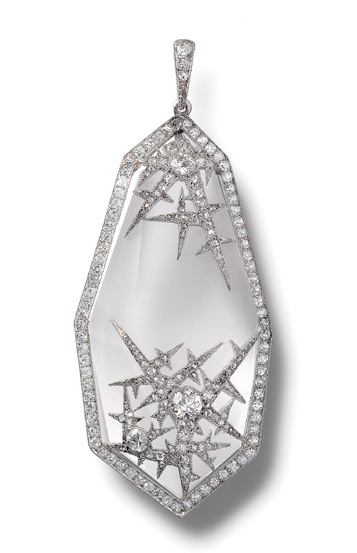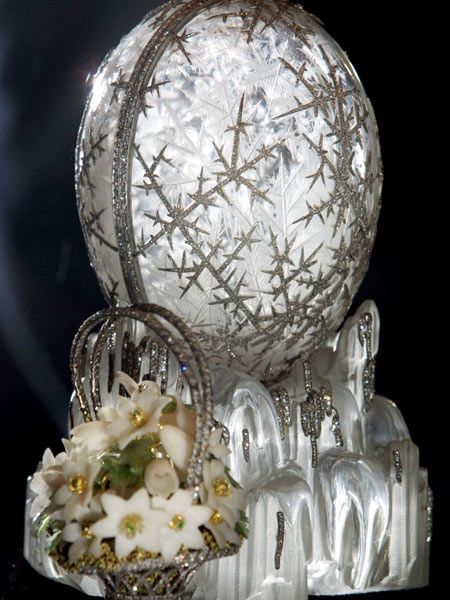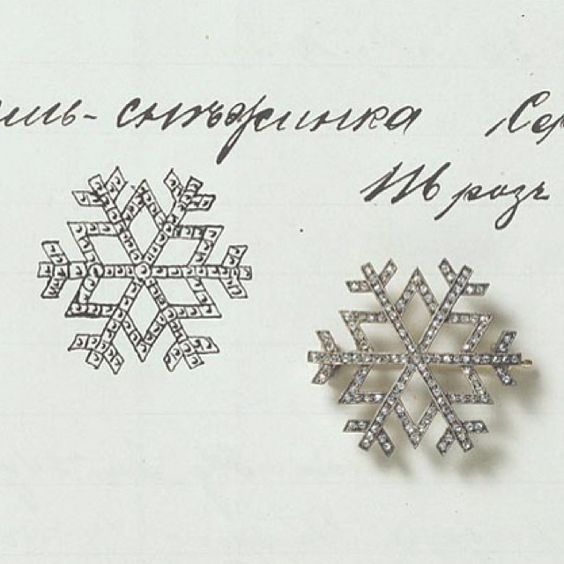Faberge Snowflakes
The depths of winter in which we now find ourselves has served as inspiration to many artists and designers. The snowflake, with its perfect symmetry and tantalisingly beautiful crystal structure has been rendered many times over in diamonds by artist jewellers throughout the last century. One jeweller, however, was key in popularising the motif in the 20th century: Carl Fabergé. He took the concept of ice and snow and made it his own, and how fitting that this should be done by a Russian jeweller, a country where the extremes of winter are harsher than most of us are used to. Fabergé is mostly famous for his fabulous eggs, but his jewellery is still relatively unknown by the larger public.
Most of the fabulous, important pieces are gone, sold and melted down after the 1917 Revolution and are only known to us through portraits and archive material. His smaller, wittier pieces have survived because intrinsically they are worth very little- this is the reason why so many objects- including the famous eggs- survived in abundance.
The ice concept is remarkable for several reasons. Firstly, there was very little precedent for this kind of ultra-naturalistic kind of jewel, so it was groundbreaking in design. Most high end designers were still referencing historical styles. Art Nouveau was in its full flowering, but it was more preoccupied with a highly stylised rendering of nature rather than a realistic one. Secondly, it was the brainchild of a highly talented designer in the Fabergé workshops named Alma Theresia Pihl. She was a young woman working in what was very much a man’s world and had a unique way of looking at design- she once drew on needlepoint for her inspiration, setting small squares of coloured gems in a mosaic manner to mimic embroidery. It is a testament to her abilities that she was responsible for the designs of at least two of the Imperial Easter Eggs.
Fabergé once said: ‘I have little interest in an expensive object if its price is only in the abundance of diamonds and pearls’ and this was obvious in the way he raised relatively humble quartzes and enamels into objects of desire. He must have been thrilled when Dr. Emanuel Nobel, of dynamite fortune and subsequent prize fame came to him with a commission perfectly suited to his design philosophy. He was a generous man and wanted a present to give out to the ladies at one of his dinners. He wanted something very beautiful but not intrinsically valuable when taken apart. Alma Pihl was tasked with this brief and the first snowflake jewels were born, realised in white quartz and diamonds. The jewels were an immediate success and quickly became a staple for the firm.
The pinnacle of this theme was the 1913 Winter Egg, given by Tsar Nicholas II to his mother, Empress Maria Feodorvna. The shell is realistically engraved with a frost pattern and decorated with a criss crossing ice pattern in platinum and diamonds. Concealed inside was a basket of white flowers, a metaphor for the spring to come after the winter. Even though it was the most expensive egg ever made, the value was entirely in the craftsmanship- if you were to dismantle it and sell the component parts it is doubtful one would realise even a few thousand pounds.












